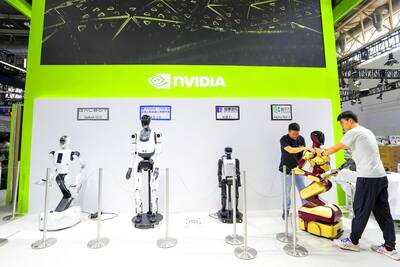HMD Global Oy, the Finnish start-up behind the revival of Nokia-brand phones, yesterday gave an optimistic business outlook in Taiwan as it launched a midrange smartphone and a refreshed feature phone.
“We are not overly concerned with declining smartphone sales in Taiwan, and believe that the continued release of new models by Nokia and other brands would stimulate the market,” HMD Global general manager for Taiwan, Hong Kong and Macau Sancho Chak (翟治豪) said at a product launch in Taipei.
Smartphone sales in Taiwan have hit a rough patch this year, with purchases plummeting to the lowest in a decade, local tech news Web site ePrice.com.tw said.
Sales fell to 490,000 units in April, down 8.5 percent annually and 23.1 percent from March, ePrice said.
Sales temporarily rebounded to about 520,000 units in May, but fell back to 450,000 units last month, the Web site said.
Market observers said that the decline was made worse by price wars between Taiwan’s telecom carriers, which have been offering steeply discounted unlimited 4G data plans, which do not come with discounts on phones.
However, Chak said that the company remains optimistic about the market for replacement devices that are purchased without a contract.
HMD Global has launched 16 phone models over the past 16 months as it seeks to meet the needs of different consumers, Chak said, adding that there would be no significant changes to its distribution strategy in Taiwan.
The company yesterday launched the mid-range Nokia 6.1 Plus smartphone — an international version of the Nokia 6X, which was released exclusively in China last month.
The Nokia 6.1 Plus is part of the Android One program and runs an unmodified version of the Android operating system to ensure the most fluid user experience and timely software updates, Chak said.
The Nokia 6.1 Plus runs Android Oreo 8.1 out of the box and is to upgrade to the upcoming Android P, Chak said, adding that the international version has noticeably different software from the Chinese variant.
The new Nokia 8110 feature phone runs an updated version of the KaiOS mobile operating system for feature phones, giving it modern capabilities including 4G Wi-Fi tethering, Google’s widely used search, assistant, maps and e-mail services, and YouTube.
The “refreshed” Nokia 8110 feature phone is not aimed at the niche market of older consumers, Chak said.
The company shipped more than 70 million handsets last year, a significant portion of which were feature phones, Chak said, adding that that 66 percent of buyers were “millennials” between the ages of 22 and 37.
HMD Global is to focus on digital marketing to build brand loyalty among younger people, who are less receptive to traditional marketing campaigns, Chak added.

UNCERTAINTIES: Exports surged 34.1% and private investment grew 7.03% to outpace expectations in the first half, although US tariffs could stall momentum The Chung-Hua Institution for Economic Research (CIER, 中華經濟研究院) yesterday raised its GDP growth forecast to 3.05 percent this year on a robust first-half performance, but warned that US tariff threats and external uncertainty could stall momentum in the second half of the year. “The first half proved exceptionally strong, allowing room for optimism,” CIER president Lien Hsien-ming (連賢明) said. “But the growth momentum may slow moving forward due to US tariffs.” The tariff threat poses definite downside risks, although the scale of the impact remains unclear given the unpredictability of US President Donald Trump’s policies, Lien said. Despite the headwinds, Taiwan is likely

When Lika Megreladze was a child, life in her native western Georgian region of Guria revolved around tea. Her mother worked for decades as a scientist at the Soviet Union’s Institute of Tea and Subtropical Crops in the village of Anaseuli, Georgia, perfecting cultivation methods for a Georgian tea industry that supplied the bulk of the vast communist state’s brews. “When I was a child, this was only my mum’s workplace. Only later I realized that it was something big,” she said. Now, the institute lies abandoned. Yellowed papers are strewn around its decaying corridors, and a statue of Soviet founder Vladimir Lenin

UNIFYING OPPOSITION: Numerous companies have registered complaints over the potential levies, bringing together rival automakers in voicing their reservations US President Donald Trump is readying plans for industry-specific tariffs to kick in alongside his country-by-country duties in two weeks, ramping up his push to reshape the US’ standing in the global trading system by penalizing purchases from abroad. Administration officials could release details of Trump’s planned 50 percent duty on copper in the days before they are set to take effect on Friday next week, a person familiar with the matter said. That is the same date Trump’s “reciprocal” levies on products from more than 100 nations are slated to begin. Trump on Tuesday said that he is likely to impose tariffs

READY TO BUY: Shortly after Nvidia announced the approval, Chinese firms scrambled to order the H20 GPUs, which the company must send to the US government for approval Nvidia Corp chief executive officer Jensen Huang (黃仁勳) late on Monday said the technology giant has won approval from US President Donald Trump’s administration to sell its advanced H20 graphics processing units (GPUs) used to develop artificial intelligence (AI) to China. The news came in a company blog post late on Monday and Huang also spoke about the coup on China’s state-run China Global Television Network in remarks shown on X. “The US government has assured Nvidia that licenses will be granted, and Nvidia hopes to start deliveries soon,” the post said. “Today, I’m announcing that the US government has approved for us